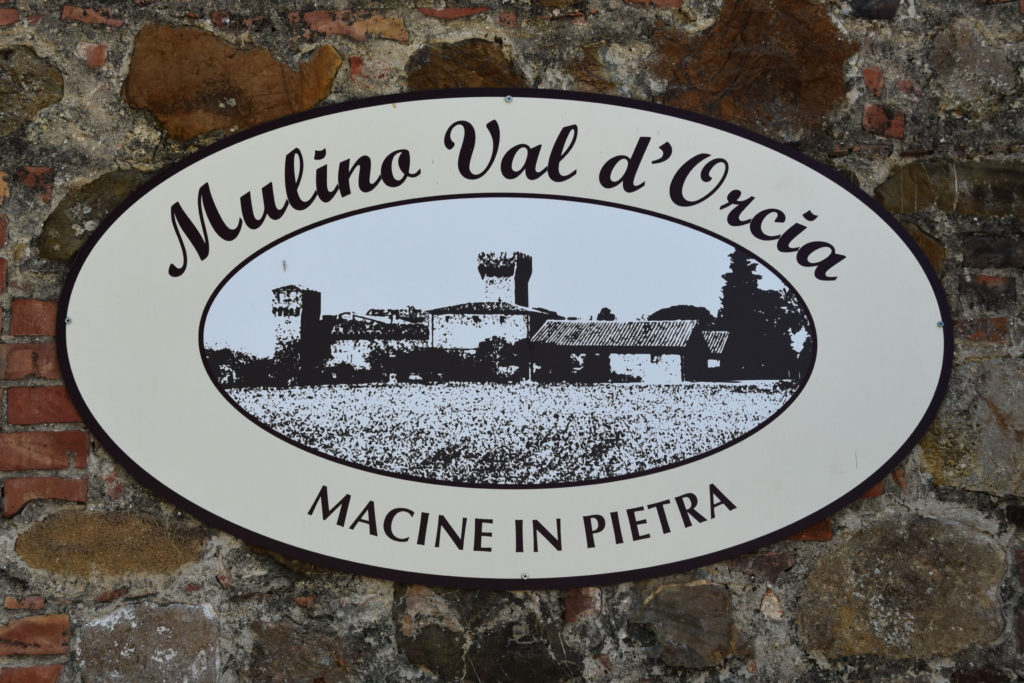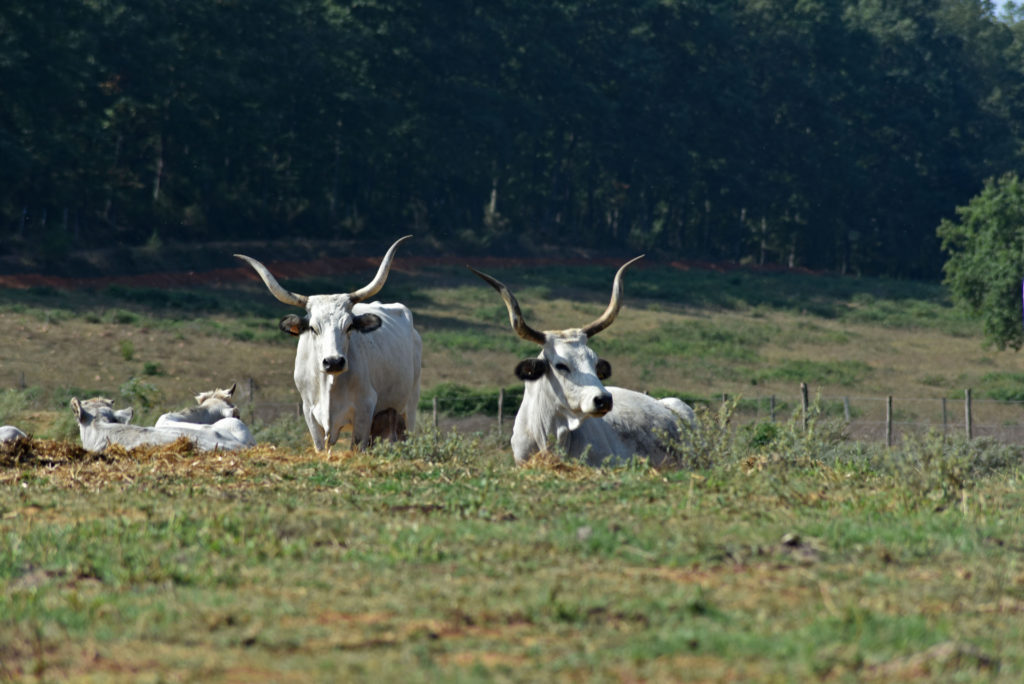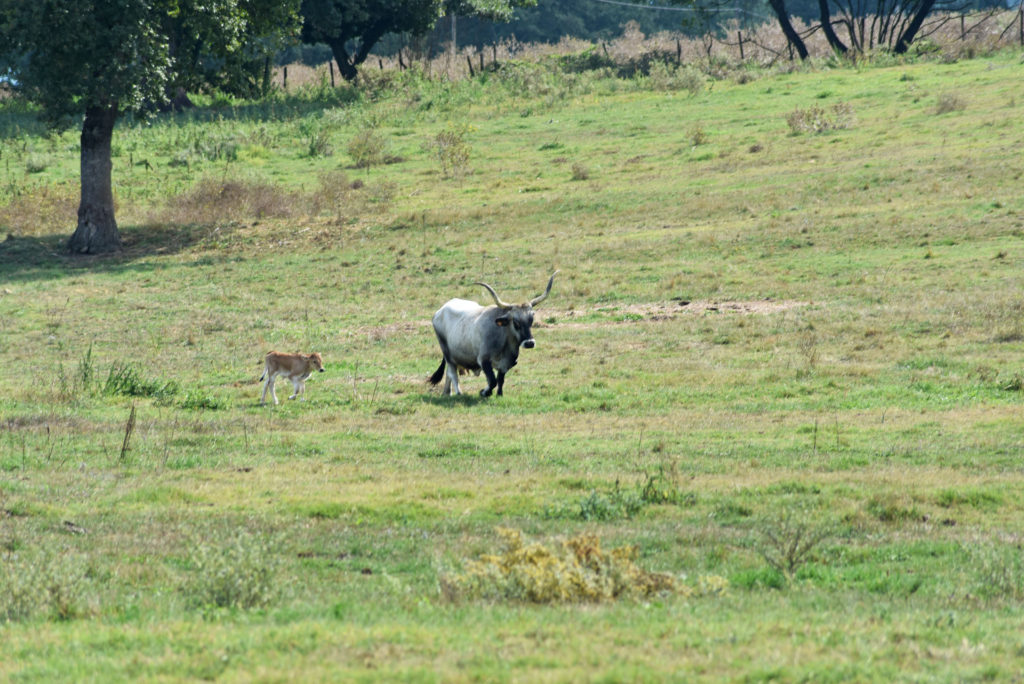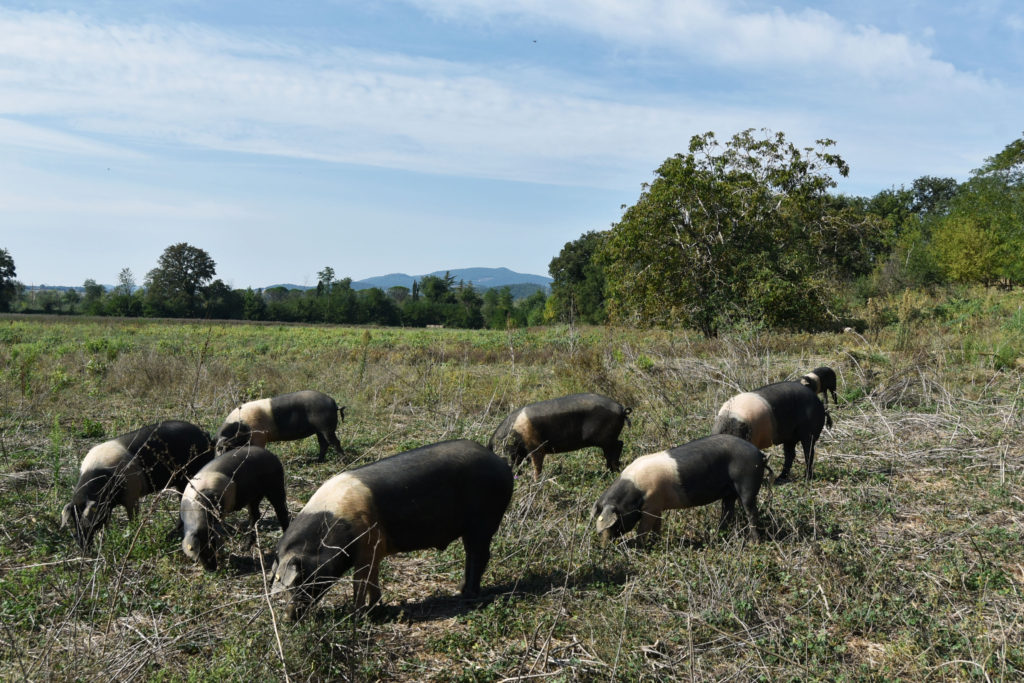By Dr. Francesco Tiezzi, Department of Animal Science at NC State & Ashley See, CFSA Communications Coordinator | Thursday, Aug. 8 2019 –

This month, we finish taking a closer look at the farms and food of central and southern Italy by exploring four different farms or farm businesses that produce specialty meats or pasta. In this specific line-up, we’re excited to discuss:
- Mulino Val d’Orcia – A pasta-to-plate farm, mill, and restaurant
- Macelleria Belli – A 50-year-old butchery
- Tenuta La Fratta – A farm raising one of the oldest breeds of cattle in the world
- Tenuta di Paganico – A farm that has grazed its heritage cow and pig breeds in a peculiar silvopastoral system since the 1920s and produces its own cork
Read on to learn about the unique ways that these producers are modernizing the craft of some of the most beloved traditional foods throughout Italy.
And if you’re wondering why CFSA is talking about farming in Italy, then you may have missed our kickoff article by CFSA Executive Director, Roland McReynolds, who attended the trip or part-one of the series where we looked at three very different dairies using three very different kinds of milk–sheep, water buffalo, and cow–to make cheese.
Disclaimer: There are some photos of raw meat below.
Mulino Val d’Orcia

Mulino Val d’Orcia is a certified-organic farm located in Pienza (a province of Siena, a region of Tuscany). The farm consists of 90 hectares (220 acres) of cropland, where cereals and legumes are grown, in addition to 10 hectares (25 acres) of vineyards and olive tree plantations. The farmland is mostly located on the hillsides, where soil composition can reach up to 70% clay. Due to this, and the annual rainfall of 700 mm (~28 inches), the farm currently grows winter crops only, like wheat (soft, durum, and spelt), chickpeas, and lentils.

Since the mid-2000s, the Mulino (mill) processes all harvested cereals into flour and pasta on the farm. A shop has been built in a renovated barn, where the visitors can see all the raw produced and processing steps while shopping. Customers can buy dry pasta, flour, legumes, and bread, which is baked in a bakery nearby. The farm prevalently grows heirloom varieties, which can give the pasta an unusual taste and texture.


Recently, the Mulino opened an on-farm restaurant, featuring a menu centered around their own products–produce from the garden, bread, antipasto with traditional recipes, pasta, and dessert.
The Mulino has set up an interesting path that shows the pasta processing from grain to plate. First, a demonstration of the milling and formation of the pasta is performed in front of the visitors (see below). Then the fresh, not-yet-dry pasta is directly brought to the kitchen, where it’s cooked and served immediately. The whole pasta dish is prepared in less than 30 minutes, which allows the use of the whole grain (avoiding oxidation of the oils in the germ) and preserves freshness. The result is a unique flavor, which is hardly found in commercial, dry pasta.

Macelleria Belli – a 50-Year-Old Butchery in Tuscany

Founded in 1969, Macelleria Belli is a second-generation butchery located in Torrita di Siena (province of Siena, a region of Tuscany) that just celebrated their 50-year anniversary.
Specializing in selling fresh and processed pork, as well as local beef, Macelleria Belli has grown significantly in the last two decades thanks to intensive marketing in connection with the territory and local traditions.

Macelleria Belli has been featured several times on local and national TV. It is the processing of pork into traditional products to be the core business of the Macelleria. Top cured products are prosciutto (ham), capocollo (pork meat taken from the neck), lombo (loin), and spalla (shoulder). Fermented products are different types of salami, from the fine-ground to the one traditional of Tuscany, with more coarse grinding of the meat. Cooked products, such as mortadella and soppressata, are also made.


Want more:
- Valdichiana Eating has a nice write up of the butchery if you’re wanting to know more!
Tenuta la Fratta – a beef farm raising one of the oldest breeds of cattle in the world

Tenuta la Fratta is a certified-organic farm located in Sinalunga (province of Siena, a region of Tuscany). The Tenuta is a beef cattle farm, which origins date back to the thirteenth century. The farm raises only Chianina cattle, original of the area Val Di Chiana–the same breed that’s been raised on the land for centuries. The Chianina breed can be traced back to the age of the Roman Empire, where it was used to pull wagons during the official parades.
The Tenuta has about 350 hectares of plain, fertile land, in addition to 50 hectares of vineyards, olive tree plantations, and hillside land. The 800 mm (31.5 inches) annual rainfall is concentrated in the fall and spring, but irrigation is available on the farm to supply water to summer crops and warm-season grasses.

The breeding herd is registered to the national herdbook and counts approximately 130 cows and 2-3 bulls. The herd is kept in a loose-stall barn with access to an external paddock. All the forage and grain are grown on the farm. Animals born on the farm are kept as replacements or brought to market weight, around 700 kgs (~1,500 lbs) for the males and 500 kgs (~1,100 lbs) for the females, which can take 16-20 months. It should be noted that the Chianina is known as the largest bovine breed since most performing animals can reach 1000 kgs (~2,200 lbs) in 30 months with a peak in daily gain of up to 2 kgs (~4.4 lbs) per day. The breed shows a dolichomorphic build–long legs, thin skeleton, and poor fat deposition, which is typical of Mediterranean breeds. The Chianina can sustain body mass growth until 30-36 months of age. Since the Chianina keeps the characteristics of a younger animal (high tenderness and low saturation of fat) at market weight, the meat is considered extremely high quality.

The farm markets the meat through a local butcher shop located in the neighboring town of Torrita di Siena, as well as the on-farm restaurant (pictured above). The restaurant, La Toraia, is placed in what used to be the bull barn and features dishes based on the farm-raised beef and game meat caught on the farmland.
Tenuta di Paganico – a pasture-raised beef and pork farm
Tenuta di Paganico is a certified-organic farm located in Civitella Paganico (province of Grosseto, a region of Tuscany). The farm is oriented towards the production of pasture-raised beef and pork.

The farm extends for almost 1500 hectares (~3,700 acres) with most of its land in woods (oak, holm oak, arbutus, Erica spp.) and 300 hectares (~740 acres) of cropland, some of it irrigated.


Since the 1920s, the Paganico has adopted a peculiar silvopastoral system for grazing the livestock to take advantage of the massive amount of land for animal foraging and natural dispersion of feces. The farm now exclusively raises heritage breeds, such as Maremmana beef and Cinta Senese pork.

The Maremmana is originally from Maremma, a stripe on the western coast of central Italy. The breed has been raised extensively for centuries and the harsh conditions of the area shaped the breed to be extremely resilient. The animals maintained sexually-dimorphic horns, half-moon-shaped in the males and lyre-shaped in the females. The horns are needed, especially in extensive silvopastoral systems, for protection, social interactions, and to open passways through the woods. The farm has tailored herd management to be as close as possible to the animals’ natural behavior. For example, cows drift away from the herd to prepare for calving, returning to the herd when the newborn calf is ready to walk independently.

The pastured-pork operation usually runs on farm cropland, well included in the crop rotation so that the activities and manure of the pigs can provide regeneration of the soil. Cinta Senese are also frugal, making them capable of taking advantage of some forage and weeds. The moderately low weight gain with a high-fat composition makes the pigs strong and resilient in case of suboptimal environmental conditions, such as scarce forage and high parasite pressure.


Agritourism is no stranger to Paganico, which also operates a farm-to-table restaurant with meals prepared with its farm bounty as well as other products raised nearby. The masterpiece is certainly the meat and charcuterie dishes. With the meals, blind taste-tests are organized.


Above, meat from the farm was compared to meat purchased from outside the farm, prepared as a tartare steak (raw meat with delicate seasoning). The meat from outside the farm comes from feedlot farms where animals from cosmopolitan breeds are fed total-mixed ratios with a high content of corn silage and soybeans. The taste test aims to compare the opposites of the production systems rather than just two breeds or two diets. Participants are not told about the origin of each sample but are asked to record their perception and preference of each on the provided chart. At the end of the test, the true origin of the meat is disclosed so that participants can match their impression to its production system. This blind test aims to train participants to find differences in the samples without the influence that the origin of the sample might play.

Last but not least, Paganico wholesales a variety of other products, including cork. The cork is extracted from the bark of oak trees, which grow predominantly in the Mediterranean basin. Such bark is extracted by skilled personnel every 15-20 years. The farm organizes a tour with snacks to witness the extraction performed without the use of equipment. Check out the farm’s video below on the process.
Want more?
This post is part of a two-part series. If you missed part one, see A Closer Look: The Farms & Food of Central & Southern Italy (Pt. 1), where we look at three very different dairies using three very different kinds of milk–sheep, water buffalo, and cow–to make cheese.
If you want to read more about the trip from our executive director’s perspective, don’t miss Roland’s article.
It’s worth noting that Dr. Tiezzi is organizing another trip for this fall. The 2019 tour will run from Sept. 28 to Oct. 6 and focus on Tuscany, with another outstanding lineup planned. Get more information on the 2019 trip here.
All photos courtesy of Dr. Francesco Tiezzi


